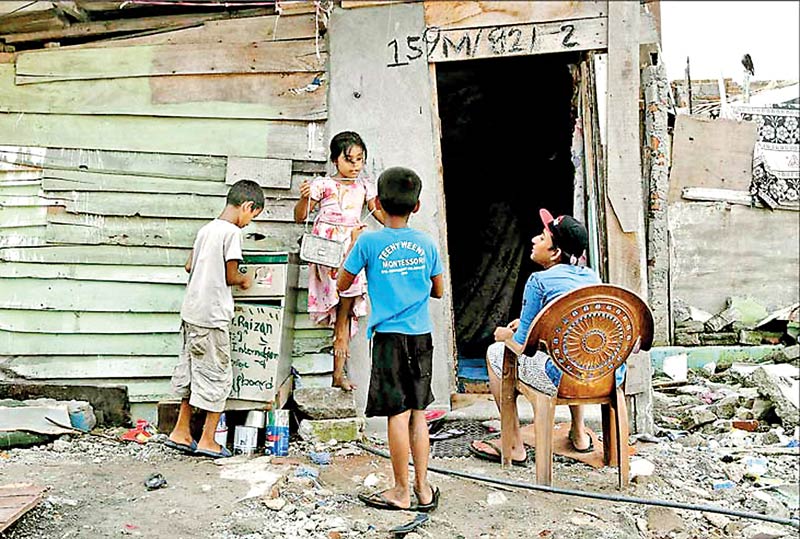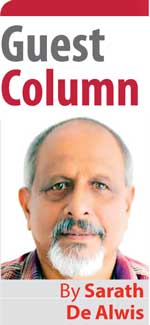Monday Dec 15, 2025
Monday Dec 15, 2025
Tuesday, 12 March 2024 00:10 - - {{hitsCtrl.values.hits}}

Malnutrition stunts the brain and affects the body. It is not an issue to be resolved in 2048 – Pic by Shehan Gunasekara
 Contrary to claims of ‘technocrats’ claiming robust progress, there is real, visible, touchable and detectable misery in the heartland. According to the latest WFP country report 17% of the population is facing moderate acute food insecurity. 31% of children aged under 5 are malnourished. 20% of children aged under 5 suffer from wasting. People are compelled to skip meals, beg, or borrow food, or simply learn to live in the gutter, staring at stars
Contrary to claims of ‘technocrats’ claiming robust progress, there is real, visible, touchable and detectable misery in the heartland. According to the latest WFP country report 17% of the population is facing moderate acute food insecurity. 31% of children aged under 5 are malnourished. 20% of children aged under 5 suffer from wasting. People are compelled to skip meals, beg, or borrow food, or simply learn to live in the gutter, staring at stars
 In his recent update to Parliament on the nation’s economy, President Wickremesinghe claimed that it is “widely acknowledged” that Sri Lanka has achieved a certain level of economic stability.
In his recent update to Parliament on the nation’s economy, President Wickremesinghe claimed that it is “widely acknowledged” that Sri Lanka has achieved a certain level of economic stability.
“We’re diligently strengthening the economy each day, striving tirelessly to improve the lives of our people and fortify the economy. Our actions are guided by a strategic plan, ensuring a systematic and methodical approach.”
He was also defiant. “Currently, we must decide whether to continue on our current path, reaping the benefits of our economic trajectory, or risk returning to a state of distress,” he added for good measure.
In an election year presumption that it is perception management isn’t unreasonable. This missive is an exploration of ground reality.
Manioc, pumpkin available mostly year-round, jackfruit and breadfruit inconveniently seasonal makeup the staple food of more than half of the population. Thanks to the availability of these substitutes, our people have learnt to mock deprivation and tease with lingering hunger.
Such nature’s bounty has helped most people to retain their capacity for robust reasoning which has made AKD the heroic truth teller to the people while unsettling the placidity of the establishment elite who see him as an undefinable ogre.
Contrary to claims of ‘technocrats’ claiming robust progress, there is real, visible, touchable and detectable misery in the heartland.
According to the latest WFP country report 17% of the population is facing moderate acute food insecurity. 31% of children aged under 5 are malnourished. 20% of children aged under 5 suffer from wasting.
People are compelled to skip meals, beg, or borrow food, or simply learn to live in the gutter, staring at stars.
There is an eloquent observation buttressed with statistics in a special report by the FAO and the World Food Program dated 25 May 2023 that demonstrates this ‘systematic and methodical approach making robust progress’.
“The percentage of households adopting livelihood-based coping strategies to access food have increased significantly, from 48% in May 2022 to 62% in March 2023, making households highly vulnerable to any future shocks.”
“Food-based coping strategies were adopted by 56% of households, 5% points less than in May 2022, but still 36% of households are reducing meal portion sizes and 19% are skipping meals.”
The level of economic stability claimed by the Presidential update is best assessed by the findings in the latest FAO report.
How stable are our paddy farmers?
“Although all paddy farmers have been affected by the economic crisis, the most severe impact has been for smallholder farmers cultivating between 0.25 and 2 hectares. They have consistently reported to the mission that the viability of their market-oriented paddy production is at risk, and, with increased production costs, they would rather orient their production toward self-consumption.”
How strategic
is our agriculture policy?
The Ministry of Finance clearly indicated to the mission its intention to move out of fertiliser subsidies.
Past years’ experiences show that sudden policy changes could result in further declines of paddy production and negative impacts on household food security. Therefore, if the Government intends to cease the fertiliser subsidy system, the mission recommends implementing it over a transition period of at least three years (2023–2026).
How stable is our ‘chicken and egg’ production?
“The mission anticipates that poultry population in 2023 will decline substantially compared to the already reduced level in 2022. The main factor for the decrease is the high cost of feed that accounts for about 65 to 75% of the production costs of layers and broilers.
Approximately 75% of chicken feed is imported. Another factor is the challenges to import parents (for layers) and grandparents (for broilers) birds for hatcheries. As a result, six of the 12 hatcheries have ceased their operation in 2022 and were still closed when the mission visited the country.”
“District authorities reported that a multitude of medium size poultry farms have also ceased their operation. Large commercial poultry farms have a better performance as they integrate vertically the production of feed and day-old chicks. Following the trend of the poultry population, production of eggs in 2023 is also expected to decrease significantly, compared with the 2022 well below-average level.”
How stable are our fisher folk?
“High energy/fuel prices to run fishing boats and to produce ice, together with increased costs of labour and equipment, such as packages, containers, and fishing gears, severely curtailed the ability of fishing communities to achieve profitable catch quantities.”
“In the coastal fishery, many fishermen have opted to use old non-mechanised boats to reduce operation costs for fishing activities. Considering these factors, the mission anticipates that offshore and coastal fish production will remain below the five-year average in 2023.”
How stable is the future of our children?
31% of our children under age five are malnourished. What will become of them in 2048? Has President Wickremesinghe considered that simple question?
He is a voracious reader. I recommend he read former RBI Governor Raghuram Rajan’s latest book co-authored with economist Rohit Lamba – Breaking the Mould Reimagining India’s Economic Future.
Speaking at a symposium at the Indian School of Business on the new book he asked how India can become a developed country in 2047 when malnutrition is prevalent.
“We are fixated with becoming a developed, rich country by 2047. I use this as an example to say, you must be joking about becoming a developed rich country by 2047 with 35 per cent malnutrition today”.
The two authors Raghuram Rajan and Rohit Lamba explain: “We don’t spend a lot of time in the book on whether it should be private ownership or public ownership.
We think that’s a tired game. Go with the ownership that works best and works best under different circumstances. A lot of the time it’s about getting the incentives right.”
Of the three current contenders for the ‘Presidency’ Ranil Wickremesinghe may have read about malnutrition. Sajith Premadasa may have heard his father speaking patronisingly about malnutrition among rural and urban poor.
Only Anura Kumara Dissa-nayake would have had to skip meals as a child and learnt firsthand to survive ‘malnutrition’.
Malnutrition stunts the brain and affects the body. It is not an issue to be resolved in 2048.
The President’s economic update in Parliament was patently a pre-election excursion into perception management.
At the risk of sounding sermonic I would like to end this missive with the concluding paragraph in the introduction to their book by the two brilliantly incisive and diligently humanistic economists Raghuram Rajan and Rohit Lamba.
They see India’s future shaped by an “irreverent, diverse, and argumentative society, at harmony with its energetic chaos, one from which creative ideas emerge that will change the world.
Instead of seeing our journey so far as an aberration and our democracy as a weakness, we should find our strengths in them and chart a path going forward that draws on the capabilities of all …”
This is the hour of the heroic truth teller.